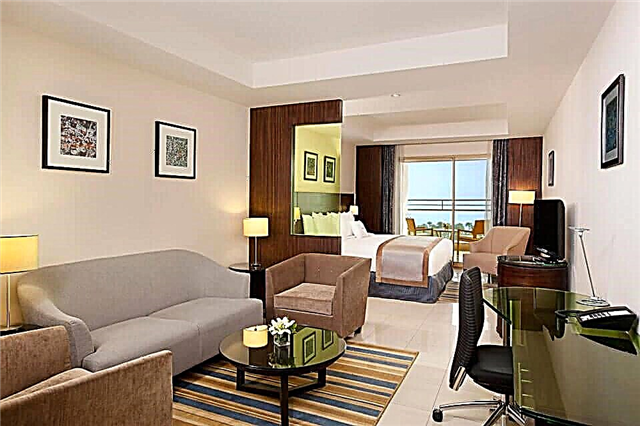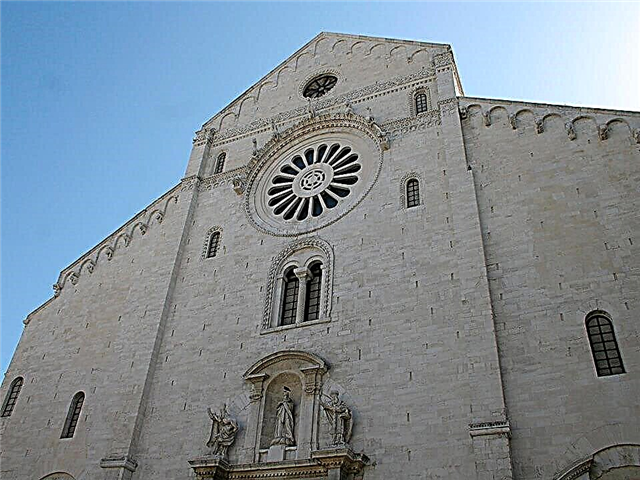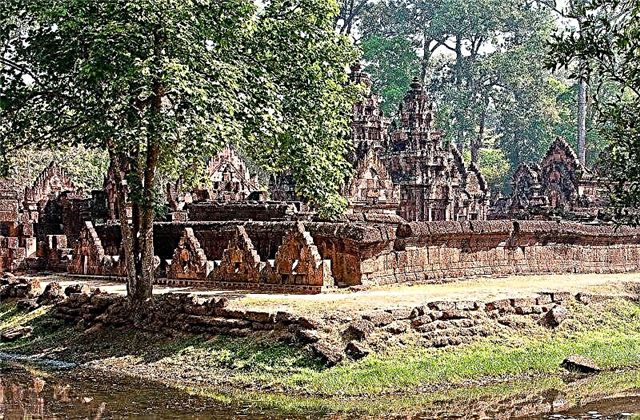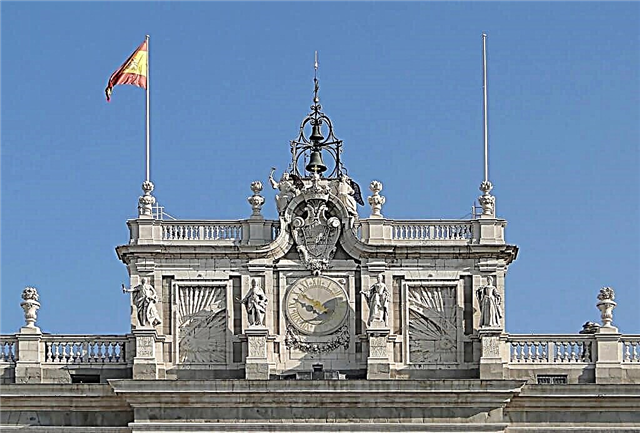The Royal Palace in Madrid (Palacio Real de Madrid) or the Oriental Palace is one of the most beautiful in Europe. The building in the Italian Baroque style amazes not only with its huge size, but also with its rich interior decoration. The palace claims to be called the main attraction of the capital and is the official residence of the Spanish kings, but since 1931 the royal family has not lived in it. Today it is used for receptions and state ceremonies, and 50 rooms are open to public visits.
Construction history
The royal residence is located in the western part of the city on the banks of the Manzanares River. The history of its origin is rooted in the distant past. In the 10th century, a Muslim state existed on the territory of Spain - the Cordoba Caliphate. By the decree of the emirs of Cordoba and Toledo, a Moorish fortress was built in the town of Magirit (present-day Madrid) to protect against the attack of the Spaniards professing the Christian faith. She was the first predecessor of the modern palace.
The second building dates back to the 16th century. During the Spanish rule of the Habsburg dynasty, the fortress was rebuilt and received the name Alcazar (Antiguo Alcázar), which translates as Old Castle. In 1561, under King Philip II, Madrid became the capital of Spain and the royal family settled in the Alcazar. The ruling dynasties lived in the castle until 1734, when the Alcazar was destroyed by fire. In its place, in 1738, under King Philip V (Bourbon), the construction of a new palace began. This was the third building on this site, which has survived to this day.
Born and living in Versailles until the age of 17, Philip V wished that his residence surpassed the splendor of the famous French palace built by his grandfather, so a grandiose building was originally planned. Construction lasted 27 years and was completed in 1764. By this time, King Philip V had already died and the first monarch who settled in the palace was Charles III. Interior decoration and surrounding areas continued until the 20th century.
Architecture

The building was designed in the late Italian Baroque style by the talented Italian architect F. Juvarro. However, he did not succeed in starting construction: in 1736 he passed away. The project was implemented by two of his compatriots: Giovanni Battista Sacchetti and Francesco Sabatini. The grandiose three-storey complex with a height of 33 meters with a total area of 135 thousand square meters has 3418 rooms, 870 windows, 240 balconies, 110 doors and 47 flights of stairs. It has the shape of a square with a side length of 130 m, inside which there is a spacious courtyard surrounded by a gallery with numerous arches.

Fearing a fire, wood was not used in construction. The building was built of white stone, gray granite, marble was used for decoration. Doric and Ionic pilasters, sculptures of crowned persons, graceful balconies are located along the facade. The upper part of the façade is surrounded by a raised cornice with a balustrade along the perimeter.

The main entrance is on the south facade. Above it there is an attic with the coat of arms of the Bourbon dynasty and a majestic sculpture "Triumph of Spain", below - a magnificent tower clock. In front of the entrance there is a large Armory Square, bounded by symmetrical buildings, decorated with gilded lanterns. It is here that a solemn ceremony takes place, attracting many tourists - the changing of the guard with the participation of the royal guards and horsemen.
Interior

The best European craftsmen have been working on the interior decoration of the palace for many decades. At the entrance opposite the grand marble staircase designed by Francesco Sabatini, guests are greeted by a statue of Carlos III in armor. The luxurious rooms are decorated with frescoes and paintings by famous Flemish, Venetian, Spanish masters, crystal chandeliers, mirrors, candelabra, Empire and Rococo furniture, magnificent sculptures.
The Throne Room or the Hall of Ambassadors is designed to receive distinguished guests and ambassadorial delegations. The central place is given to two gilded thrones of the 18th century, which stand on a hill surrounded by four guards - bronze lions. On the sides there are sculptures symbolizing Prudence and Justice. The vault is painted with frescoes by the Venetian master Giovanni Batista Tiepolo. The walls are covered with red and gold velvet, and the silver chandeliers are considered the most beautiful in the palace. On the walls there are mirrors in rich gold frames, crystal candelabra. Here is also the famous painting by Caravaggio "Solome with the head of John the Baptist."

The porcelain room with delicate light green ceramic panels on the walls enchants with its grace and decoration. They depict wreaths, cups, garlands very realistically. In the Royal Salon, or the Gasparini Room, the walls are upholstered in light silvery silk with floral designs. The plafond above the massive chandelier is decorated with the work of the German master Anton Raphael Mengs "The Apotheosis of Trajan". On the walls there are magnificent mirrors, candelabra, a portrait of Carlos IV by Francisco Goya. In the center of the room is an elegant mosaic table with golden birds pecking grains. The author of the project of the hall is the Neapolitan master Matias Gasparini, after whom he is often called.
Striking with pomp The dining room, intended for banquets. More than 140 people were seated at the long table at the same time. The interior is decorated with tapestries by Flemish artists of the 16th century, frescoes by Antonio Vasquez made in cinnabar, the finest Chinese vases of the 17th century, and crystal chandeliers.
Museum treasures

Visitors to the Palace are given the opportunity to see treasures that have become relics. These are paintings and frescoes by outstanding artists: Caravaggio, Francisco Goya, Diego Velazquez, Giovanni Battista Tiepolo, Corrado Giaquinto, etc.
The armory contains a collection of weapons and armor from the Middle Ages to the 19th century, including those that belonged to Kings Charles V, Philip IV, Maximilian I. Finely crafted jewelry belonging to monarchs is mesmerizing with its splendor and grace: tiaras studded with diamonds, emeralds, topazes , pendants, cameos. There is also a royal crown inlaid with precious stones and a scepter with a crystal ball.
The collection of old pharmaceutical supplies is unique, represented by recipes, glass and porcelain vessels, herbaria of medicinal herbs and a laboratory for the manufacture of medicines of the 17th century. An interesting watch, not only showing the time, but playing various melodies: trills of birds, sounds of a flute, flutes and equipped with mechanical moving figures. The monarchs were obsessed with the passion of collecting watches, so there are more than 700 of them in the palace.
Music connoisseurs are delighted with the collection of stringed instruments, including exhibits made by the famous Stradivarius master. It is impossible not to mention the library, which occupies 24 rooms. It contains the rarest old books in exquisite bindings, coins, minting, medals.
Adjacent gardens and parks

The palace is surrounded by magnificent green parks. On the north side, a wide staircase leads down to the Sabatini Garden, which is located on the site of the Royal Stables, designed by the great master. The garden with an area of 2.5 hectares was founded in 1933 by F. Mercadel. The central place is occupied by a rectangular pond with a mirror-clear surface. Snow-white statues of monarchs rise along the perimeter. Perfectly trimmed boxwood mazes grow green all around. The alleys are planted with evergreen conifers, cypresses, magnolias, among which pheasants, turtledoves, and wild pigeons feel great.The Sabatini Garden was opened to the public in 1978.
From the west of the palace towards the Manzanares River, on an area of 20 hectares, there is a huge Campo del Moro Park (Mauritanian Field). The name comes from the fact that a Moorish camp stood on this site in the 12th century. The project of the park belongs to Narcisso Pascual Colomer, it was brought to life by Ramon Oliva.
In 1844, the Moorish field was transformed into a park area for the royal children to play. After 20 years, they began to build a large garden and park complex: they planted 10 thousand deciduous trees, many shrubs, equipped flower beds, lawns, and rose gardens. It acquired its modern look by 1890.
There are many trees in the park that are over 100 years old. Palms, cedars, sequoias, chestnuts, cypresses, etc. grow in the neighborhood. Magnificent flower beds, Tyrolean houses, gazebos, white marble fountains, artificial grottoes and caves - all this adds a touch of grace and romanticism. The magnificent peacocks fearlessly walk along the green lawns, fluffing up their fantastically colored tails, and snow-white swans swim in the pond. At the very end of the park there is the Museum of Carriages, where unique specimens of royal carriages, landau, gigs, carriages are collected.
Opening hours and ticket prices
Schedule:
- October - March, daily from 10:00 to 18:00
- April - September, daily from 10:00 to 20:00
Ticket offices close an hour earlier. Closed on the following days: January 1 and 6, May 1, December 25. The ticket price is 10 €, children under 5 years old - free of charge, from 5 to 16 years old and after 65 years old - 5 €. Audio guide - 4 €. The parks are free to enter.
Where is it located and how to get there
The palace is located in the center of Madrid on the Plaza de Oriente. Visitor access: at the corner of Baylen Street.
Bus: No. 3, 25, 39, 148 to the San Quintin stop
Metro: Lines 5 and 2 (Opera station), then walk 5 minutes.
We recommend the following hotels in Madrid:











